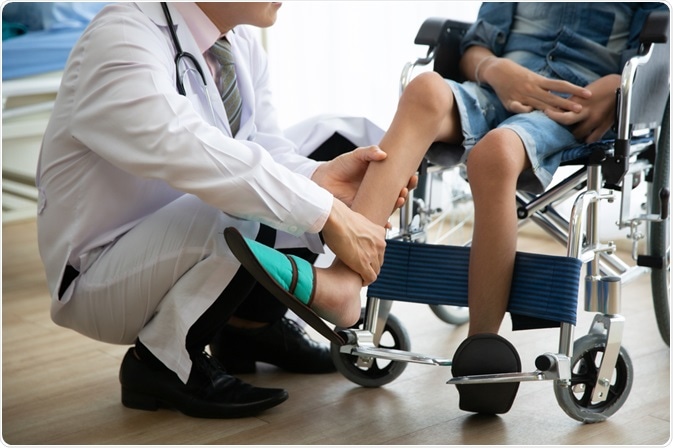Muscular dystrophies represent a group of inherited primary diseases of muscle, characterized by muscle fiber degeneration and muscle weakness. Classification of these conditions has traditionally been based on pathologic, clinical and inheritance patterns. Even though there are some common symptoms pertaining to muscle weakness, specific syndromes exhibit some characteristic clinical manifestations.
 Image Credit: Dan76 / Shutterstock.com
Image Credit: Dan76 / Shutterstock.com
Muscle weakness in muscular dystrophy
The muscle weakness that occurs in all different types of muscular dystrophy shares certain characteristics. First of all, it is most often symmetrical, i.e. the weakness on both sides of the body is often very similar (even though one side sometimes seems more affected than the other).
The weakness is usually progressive, although it often shows periods of apparent arrest. Some types of muscle weakness begin during infancy or early childhood years with severe course, whereas others that come on in later life may be very mild. The slowing is often most evident either in the early stages or (more commonly) when a person becomes dependent on a wheelchair.
Pain usually does not accompany weakness, and the muscles are not tender to touch. In certain types of dystrophies that affect the major limb muscles, stiffness and cramps are known to occur (albeit severe forms of cramping are quite unusual). Contractures can arise as a result of prolonged immobilization, which can be avoided with physiotherapy and other preventative measures.
The course and severity of a disease, as well as its prognosis, depends on the specific type of dystrophy from which a person is suffering; hence, a precise diagnosis is essential. A careful history taking and examination by a doctor experienced in the disease and relevant laboratory tests are pivotal in establishing the diagnosis and plan the therapeutic process.
In certain types of dystrophy, muscles can sometimes seem enlarged rather than wasted. Contrary to the muscle enlargement in athletes, these muscles are weak and thus referred to as pseudohypertrophy. The cause of this condition is not entirely clear, but it probably arises due to the muscle tissue becoming replaced by fat and connective tissue.
Clinical manifestations of specific conditions
In Duchene muscular dystrophy symptoms usually appear before age 6 and may appear as early as infancy. Weakness begins in the upper legs and pelvis, and affected children fall down a lot, have problems with motor skills (running, jumping and hopping), and exhibit pseudohypertrophy. Symptoms can also include fatigue, learning difficulties (the IQ can be below 75) and possible intellectual disability.
Becker muscular dystrophy is less severe than Duchenne muscular dystrophy, thus the main distinction is that people with this condition can still walk at 16 years (and some continue to do so into advanced age). They may have cramping in their muscles, certain difficulties rising from the floor and often walk on their tiptoes.
Facioscapulohumeral dystrophy is a form of muscular dystrophy that affects the face and shoulders, so typical features include weakness of eye closure muscles, impaired reflexes at the biceps and triceps muscle, trouble swallowing and speaking, as well as occasional hearing difficulties.
The most pronounced symptom of myotonic muscular dystrophy is the inability to relax muscles following a sudden contraction. It most often affects both women and men between the ages of 20 and 30, and other clinical manifestations include drooping eyelids and vision problems, swallowing difficulties, long and thin face, weight loss, baldness, cardiac disease, testicular atrophy and adverse reactions to anesthesia.
The term congenital muscular dystrophy is used for a group of muscular dystrophies united by the fact that muscle weakness begins in infancy or very early childhood (typically before the age of two). These conditions can make an infant seem “floppy”, and later the infants are slow in reaching motor milestones such as sitting up, rolling over or walking. Some of the rarer forms of congenital muscular dystrophy are also accompanied by mental retardation or learning disabilities.
Duchenne & Becker muscular dystrophy - an Osmosis Preview
The early signs of Emery-Dreifuss muscular dystrophy include walking on toes due to the stiffness of Achilles' tendons in heels, difficulties in bending the elbows and the possibility of fainting because of heart abnormalities. Shoulder deterioration and rigid spine are also often present. Mild weakness in facial muscles can also be experienced.
Limb-girdle muscular dystrophy, like other muscular dystrophies, primarily represents a disorder of voluntary muscles. People with this condition often notice a problem when they encounter weakness of the hip and leg muscles. Weakness in the shoulder area makes reaching over the head and carrying heavy objects difficult. Limb-girdle can exhibit quick or slow progression, but most patients become severely disabled within 20 years of developing the disease.
Rare forms of distal myopathies are associated with weakness and wasting of distal muscles – most often without the noticeable involvement of other muscle groups. On the other hand, oculopharyngeal muscular dystrophy is characterized by late adulthood onset of progressive ptosis and dysphagia, followed by involvement of other cranial and limb muscles.
References
Further Reading
Last Updated: Nov 21, 2022